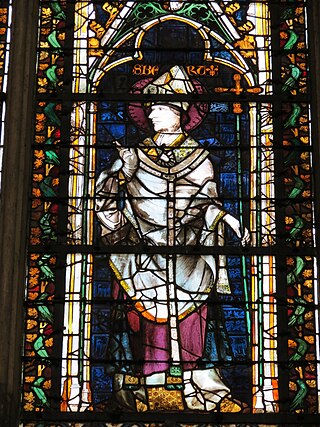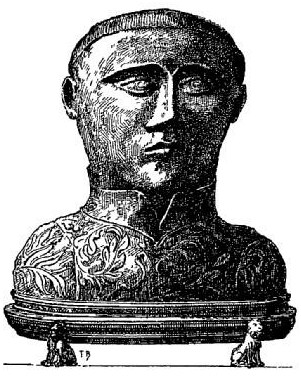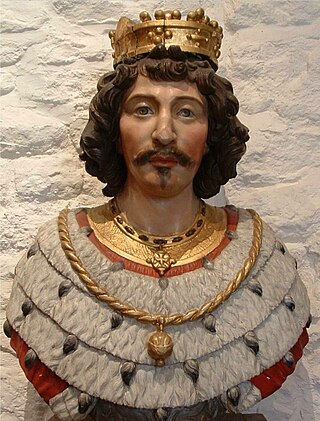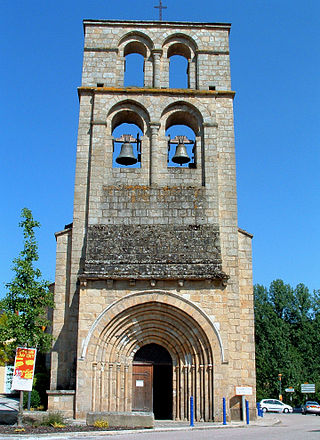Baring-Gould's account
According to Sabine Baring-Gould, Vulmar was the son of a Frankish nobleman named Vulbert. When he was a young man he was married to a girl named Osterhilda. However, when she was a child she had been promised by her parents to someone else. That person complained to the king of the Franks, who ordered the separation of the young couple and gave Osterhilda to the person to whom shed had been betrothed. Vulmar reacted by turning his back on the world and joining the monastery of Hautont in Hainault. He was given the job of looking after cows.
Eventually Vulmar was ordained a priest, but decided to live alone in the oak forest. For many years he lived in the Eeken forest, but when he was discovered returned to his place of birth and built a hermitage in the forest near Samer. Over time both male and female disciples joined him, and he built two monasteries in the forest, one for men that he led and one for women under his niece Eremberta. In 688 Ceadwalla, king of the West Saxons, visited him there while travelling to Rome, gave him 30 sous and said he would pray for him. Vulmar died of old age just before or after the start of the 8th century and was buried at Samer. The Huguenots later scattered his bones.

Gall according to hagiographic tradition was a disciple and one of the traditional twelve companions of Columbanus on his mission from Ireland to the continent. However, he may have originally come from the border region between Lorraine and Alemannia and only met Columbanus at the monastery of Luxeuil in the Vosges. Gall is known as a representative of the Irish monastic tradition. The Abbey of Saint Gall in the city of Saint Gallen, Switzerland was built upon his original hermitage. Deicolus was the elder brother of Gall.

Richarius of Celles was a Frankish hermit, monk, and the founder of two monasteries. He is venerated as a saint in the Catholic and Eastern Orthodox Churches.

July 19 - Eastern Orthodox Church calendar - July 21

Ansbert, sometimes called Ansbert of Chaussy, was a Frankish monk, abbot and bishop of Rouen, today regarded as a saint in the Catholic Church and Eastern Orthodox Church.

Saint Waltrude is the patron saint of Mons, Belgium, where she is known in French as Sainte Waudru, and of Herentals, Belgium, where she is known in Dutch as Sint-Waldetrudis or -Waltrudis. Both cities boast a large medieval church that bears her name.

Winwaloe was the founder and first abbot of Landévennec Abbey, also known as the Monastery of Winwaloe. It was just south of Brest in Brittany, now part of France.

Vincent Madelgarius, aka Maelceadar, Benedictine monk, died 677. His feast day is September 20.
Wulfsige III was a medieval Bishop of Sherborne and is considered a saint.

October 15 - Eastern Orthodox liturgical calendar - October 17

Crespin Abbey was a Benedictine monastery in the commune of Crespin in the department of Nord, France, founded around 648 by the reformed brigand Landelin of Crespin, also the first abbot, and dissolved in 1802.

Saint Solus was an English monk, in Germany with St. Boniface.

Lomer, also known as Laumer, Laudomarus, Launomar, or Launomaro, is a Christian saint whose feast day is January 19. He founded an abbey at Corbion near Chartres in present-day France. The vita of Saint Lomer reveals that, as a youth, Lomer was a shepard, before being accepted into the monastery of St. Mesmin, near Orleans, and would eventually become a priest in Chartres. The vita also states that Lomer lived to be more than one hundred years old. One known copy of this vita was begun by Orderic Vitalis while he was copyist at the library of Saint-Évroul.

Saint Mummolin of Noyon was a monk who became an abbot in Saint-Omer, then Bishop of Noyon-Tournai in Belgium. His feast day is 16 October.
Saint Joavan was an Irish priest and bishop in Brittany.

Saint Babolen was Abbot of Saint-Maur-des-Fossés Abbey near Paris. He may have been Scottish in origin. His feast day is 26 June.

Saint Thillo was a Saxon slave who was converted by Saint Eligius and became a priest at Solignac Abbey. He accompanied Eloi in missionary work, returned to Solignac, and was made abbot. Unable to handle the responsibility, he left the abbey and became a hermit. His feast day is 7 January.

Saint Thierry or Theodoric of Mont d'Hor ; Born in march 9; died 533) was a disciple of Saint Remigius who became abbot of Saint-Thierry Abbey, near Reims, France. His feast day is 1 July.

Saint Salvius of Amiens was a 7th-century bishop of Amiens. His feast day is 11 January.

Saint Rodingus was an Irish monk and abbot in Beaulieu-en-Argonne, France. His feast day is 17 September.

Hautmont Abbey or the Abbey of Hautmont, was a Benedictine monastery in Hautmont in the department of Nord, France.
This page is based on this
Wikipedia article Text is available under the
CC BY-SA 4.0 license; additional terms may apply.
Images, videos and audio are available under their respective licenses.

















